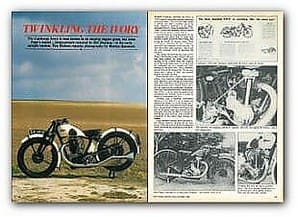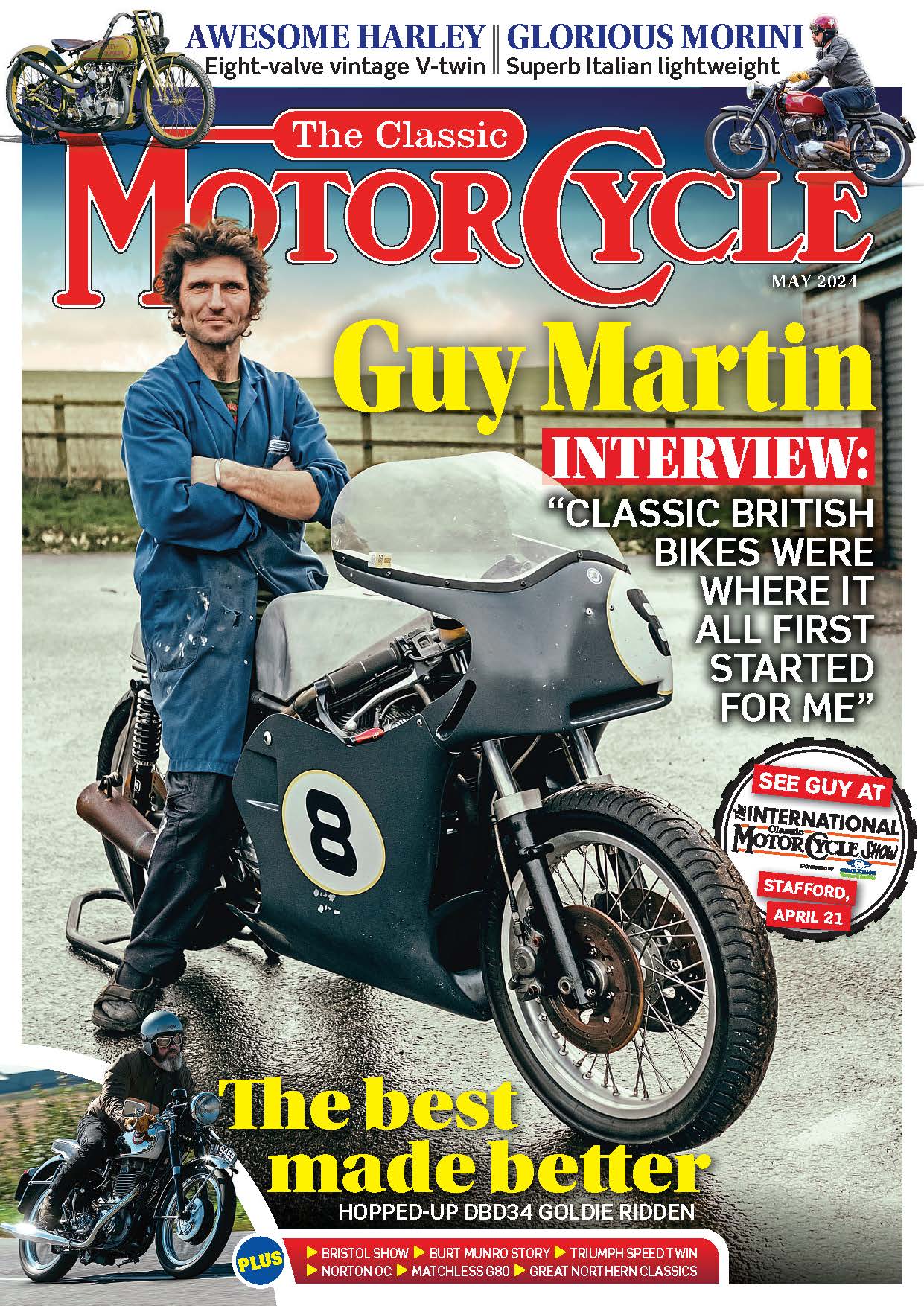
When Calthorpe launched the Ivory in 1928 it gained immediate acclaim from press and public alike. "The two-port super model is entirely new and is certainly one of the most attractive machines in its class" declared Motor Cycling on September 12th, 1928. "At 147 this machine, with its original finish should attract a ready market."
And the finish was original indeed, for the mudguards and petrol and oil tanks were painted a highly distinctive ivory colour, thus giving the model its unusual name. There could be no mistaking the new Calthorpe, and at £47 the company could truly say — as they did in their sales brochure — that it was the only enclosed OHV at anything like the price.
Enjoy more Classic MotorCycle reading in the monthly magazine.
Click here to subscribe & save.
The engine was basically the same as that fitted to the Popular model, which Calthorpe had been making for some years with changes to the cylinder head and magneto drive. Bore and stroke were 74 x 81mm, and the crankshaft ran on a double row roller bearing on the drive side, with a phosphor bronze bush on the timing side. The big end was another double row roller bearing.
Pushrods and valve rockers, which ran on rollers, were enclosed, although the rocker ends, adjusters, valve springs and stems were open. The carburettor, according to the 1928 announcements, was a Sports Amac, but it was an Amal on the production machines. The Ivory was delivered with a compression ratio of 6 to 1, but by removing gaskets from underneath the cylinder base, it could be raised to a maximum of 8 to 1.
Gearbox was a Burman three-speed (ratios 5.2, 8.2 and 13.2 to 1) which was adjusted by means of a pivot fixing, and a particularly neat touch was the hand-change lever, the quadrant of which was fixed to the side of the petrol tank and covered by the knee grip. This had the effect of making the tank design clean and tidy, and avoided the possibility of the rider's knee fouling the change.
Large diameter exhaust pipes and distinctive fishtail silencers fmished off the lines nicely, whilst the control cables for brake and clutch ran inside the handlebars to the inverted levers.
 So much for the basic specification. Everyone admitted that it looked a cracker, but how did it go? Both The Motor Cycle and Motor Cycling tested a model early in 1929 (OX 3128 in both cases), and came roughly to the same conclusion: "To sum up, it can be said that those who are in search of a fast, comfortable mount for general touring will fmd the Calthorpe very suitable." (The Motor Cycle); "Looked at as a complete motor cycle, there is evidence in its every line of thought and ingenuity behind it, while the quality of the workmanship and the equipment make it a force to be reckoned with in its own particular field." (From Motor Cycling.)
So much for the basic specification. Everyone admitted that it looked a cracker, but how did it go? Both The Motor Cycle and Motor Cycling tested a model early in 1929 (OX 3128 in both cases), and came roughly to the same conclusion: "To sum up, it can be said that those who are in search of a fast, comfortable mount for general touring will fmd the Calthorpe very suitable." (The Motor Cycle); "Looked at as a complete motor cycle, there is evidence in its every line of thought and ingenuity behind it, while the quality of the workmanship and the equipment make it a force to be reckoned with in its own particular field." (From Motor Cycling.)
Outstanding characteristics of the test machine were its handling, roadholding and steering, and its mechanical silence. At high speed the Calthorpe was stable and secure and could be heeled into fast bends without fear, while at walking pace it could be steered almost to a hair's breadth. The girder forks, said to be of Calthorpe's own manufacture, were praised for comfort and control, and the new, low duplex frame was given credit for the machine's solid feeling. The engine emitted little mechanical clatter, and the silencers cut out all offensive tones, leaving a pleasantly modulated low note. The gearbox, too, was quiet.
Braking was taken care of by two 6 inch internal expanding units, which did their job well althouglikoth testers commented on the high pitched squeaks given out by the front one.
Incidentally, the Motor Cycling test contains a revealing insight into the origin of a now famous (or perhaps infamous) test-phase, "One often reads in car journals that `the controls fell easily to hand' — they certainly did on the Calthorpe." Is this the first recorded application of those words to a motor cycle?
The Ivory Calthorpe was a success, and after one season it was decided that the Barn Lane, Birmingham, works should concentrate exclusively on the production of this one model. By then, however, the engine had been redesigned. It was, for 1930, inclined forwards ( a sloper, in other words) and the oil tank was cast integrally with the crankcase rather than being a separate piece of tinware. The rocker gear had also been altered. The 1928/29 Calthorpe Ivory is, therefore, peculiar to the type in having an upright cylinder, and despite the good sales, it is now a relatively rare machine.
This explains why, when he bought the rough wreck from an auction house in Torquay 11 years ago, John Pape did not know exactly what he'd got. A cyclemotor enthusiast and Sunbeam S7 owner, John was given the tip off by a friend who told him there was an unusual machine, left over from a house clearance auction, languishing in the auctioneer's showrooms. Taking the trip down west, John offered £70 for the Calthorpe, which he could see was more or less complete, and returned with it. At the time £70 seemed a lot of money.
The usual round of information gathering followed, with the VMCC library and articles by Bob Currie proving most useful. John intended to restore the Ivory himself, but time went by and he realised that it would be impossible for him to tackle a serious project like that for some years. Recommended to restorer Bill Healing by journalist Peter Watson, John made contact, and joined Healing's long waiting list.
Thanks to a customer dropping out, John Pape's "turn" came up sooner than expected, and a phone call from Healing led to their first meeting. Bill Healing likes to know a bit about his customers and about the way in which they will use the motor cycles he restores. In this case, the machine would be ridden in runs and rallies and it had to be mechanically original, but perfect.
Armed with these outline instructions and the research material, Bill started work on the Calthorpe. It was totally dismantled, every single part was inspected and if it was found to be worn or suspect it was replaced. In all, 138 replacement parts were fabricated, a figure which is augmented by those parts which were bought ready made.
 Dealing with the cycle parts first, a new primary chain cover was made in sheet metal (the one fitted was from a lathe); likewise the footrests, exhaust pipes and silencers. The pattern for the latter was taken directly off a Calthorpe catalogue photograph. By scaling the image up proportionately and running it through a photo mechanical transfer (PMT) machine, John Pape was able to make a lifesize two-dimensional cutout the third dimension came from a very battered old original. John has access to such facilities because he is a designer of toys, one of the few in Europe — look in any toyshop and you are bound to see something that originated at the Raffo and Pape partnership.
Dealing with the cycle parts first, a new primary chain cover was made in sheet metal (the one fitted was from a lathe); likewise the footrests, exhaust pipes and silencers. The pattern for the latter was taken directly off a Calthorpe catalogue photograph. By scaling the image up proportionately and running it through a photo mechanical transfer (PMT) machine, John Pape was able to make a lifesize two-dimensional cutout the third dimension came from a very battered old original. John has access to such facilities because he is a designer of toys, one of the few in Europe — look in any toyshop and you are bound to see something that originated at the Raffo and Pape partnership.
The silencers, as well as being a highly individual shape, have detachable fishtails. This is a Calthorpe design point and Bill Healing followed it, not because the owner wishes to sound extra rorty, but because the exhaust system runs extremely cool. and condensation and moisture can, therefore, be a problem – detachable end pieces allow regular dosing with water dispellant.
Mudguards are modified, rather than made. Armours of Bournemouth supplied the basic blades, which Bill lengthened to match the Calthorpe's catalogue appearance.
In Motor Cycling's 1929 test it was stated that the engine "was found to be definitely oil-tight". Perhaps it was, then, but this model was definitely not oil-tight, and given what the restorer had to do to make it so, it seems doubtful that it could have been really so clean. Bill's method of curing leaks is both methodical and logical. For a start, he does not follow conventional wisdom by cleaning the motor off; he leaves it dirty. The reason? He can then trace all leaks back to source, analyse the problem and devise a cure. In ling so, he has to be sure that the leaks are not intentional, for sometimes a designer would deliberately use an inferior sealing arrangement to allow oil mist or throw or dribble to lubricate an adjacent area.
Most of Bill's cures involve applying modern techniques to old internals. For example, on the Ivory the valve lifter plunger sits below the level of oil in the engine, and lubricant would leak out through its bush bearing. To overcome this the bush was lengthened and an 0-ring fitted. Similarly, the camshaft outer bush allowed a dribble out, and in this instance the bush was retained but the housing was bored out and a lipped oil seal pressed in.
Perhaps the greatest challenge lay at the top end, in amongst the semi-enclosed rocker gear. The valves are fitted with twin coil springs, normally enough, but there is also a long return spring fitted to both rockers. The dead end of these springs were anchored in dome shaped pressings attached to the rocker box. Oil would drain into the domes and spill out over the engine. In curing this one, Bill Sealed the anchor stems with 0-rings, then secured them to the housings with dome headed nuts. This is the only place on the engine where his modifications are visible.
Inside the engine Bill found the cylinder worn to a .018in clearance (although he notes wryly that the carburettor slide had an even greater clearance). By great good luck, brand new +.020in and +.040in pistons and rings were found (in the custody of Dave Goodman) so if the Calthorpe should ever require another rebore, the bit is to hand.
Valve seats had been hammered about a bit, but rather than simply recut them, Bill machined out a space around the old seats and inserted new material, partly to accommodate the new, larger valves. Already quite a size at 1 5/8 in, they were opened up to 1¾in which will no doubt help performance.
 New bearings were fitted throughout, except for the small end, which had not worn noticeably. The conrod is very strong, as it had to be since this motor was, by the standards of its day, quite "revvy". To emphasise its sporting nature, and facilitate a quick throttle response, the flywheels are light and small.
New bearings were fitted throughout, except for the small end, which had not worn noticeably. The conrod is very strong, as it had to be since this motor was, by the standards of its day, quite "revvy". To emphasise its sporting nature, and facilitate a quick throttle response, the flywheels are light and small.
The wheel bearings were also modified extensively. Calthorpe equipped the holes with cups-and-cones, but Bill machined the housings and carriers to accept modern sealed ball races. This has been done in such a way that the external appearance has not been altered.
When all the new parts had been made and assembled, the paintwork was entrusted to Mr. Machine (58 Norwich Walk, Basildon, Essex), who made a superb job of the ivory, the Calthorpe logo and the blue striping. And thereby hangs a tale, for several times John Pape has been nitpicked upon by persons saying the lines should be black. However, there is an excellent reason for them being blue.
When John acquired the Calthorpe, the tank had been painted over with a black, gungy substance. Underneath the perished knee-grips John found patches of the original paint, complete with lining, which he removed, and matched with current car colours. The lining was blue. Worried that age or some chemical reaction had altered the pigmentation, John checked over his research material. All of the catalogues said the lining was black (as do those in the Classic Motor Cycle archive) — except one, which says, clearly, in print, that the lining is blue. So blue it stayed. I have seen the relevant literature, and can only conclude that it was a very early specification — this Ivory's engine number is 5229, and registration number DV1010 was issued sometime after March 1929 by Devon County Council. Anyone wishing to take issue with the colour or design of the lining is referred to the owner, and had better be well informed.
To say that John was pleased with the finished article is something of an understatement. He quickly realised that had he done the job himself it would, by comparison with Bill Healing's craftsmanship, have been a bodge-up. The big question was — how did it go?
"To start with," says John, "I found it to be very 'veteran' — a physical feeling, lots of whirring and tapping, plenty of mechanical vibration transmitted through the frame. It is very 'laid back' in that it seems unhurried and unruffled, but it belts along and accelerates quite rapidly." Bill Healing's first impression was of the Ivory's surefootedness, and he puts a lot of that down to the rigid duplex frame. All in all, it is very much a rider's machine.
Its first big outing was this year's Banbury Run. The motor cycle was fine, but the rider got lost! This is perhaps excusable for a tyro, but he compounded it by following someone who thought he knew the way . . .
However, it was an enjoyable outing, and two nice tales came out of it. The first was a meeting with an old gent who used to sell Calthorpes; the second was overhearing a conversation between mother and daughter. It concerned her husband's purchase of an Ivory in 1946, the first motorised vehicle he had ever owned. Not knowing the first thing about mechanics, he ran the engine until it was dry of oil, then, when the inevitable seizure occurred, became so digusted with it that he threw it into a canal. "You don't," John butted in, "happen to remember which canal it was?"
Motor Cycling probably had it right all those years ago. "There is no doubt that the Calthorpe is one of the prettiest machines of the day . . . If it was left outside an office or a shop for five minutes an admiring crowd would collect — and not always were the admirers motor cyclists; over policemen, bus conductors and lorry drivers it seemed to exert a particularly strong fascination." John Pape's Ivory demonstrates clearly that although the model may not have been exclusive, it is highly desirable, and proves conclusively that a low priced, popular product does not have to be either vulgar or merely functional. When clarity of design is wedded to an ethic of value for money the theoretical result should be an outstanding example of what modern industrial practice can achieve. The Calthorpe Ivory is that theory given form. ![]() View original article
View original article
Advert
 Enjoy more The Classic MotorCycle reading in the monthly magazine. Click here to subscribe.
Enjoy more The Classic MotorCycle reading in the monthly magazine. Click here to subscribe.











